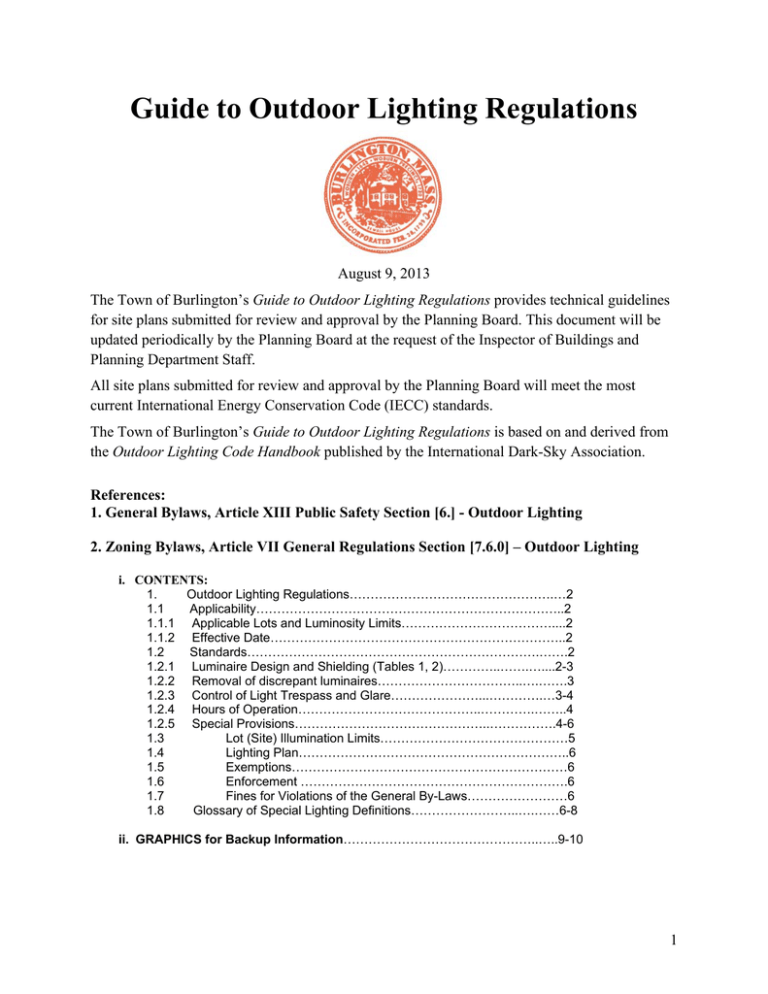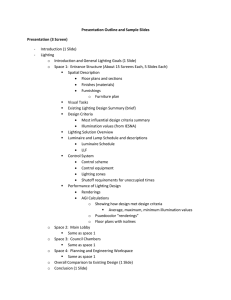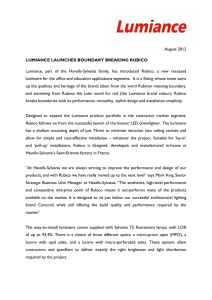Guide to Outdoor Lighting Regulations
advertisement

Guide to Outdoor Lighting Regulations August 9, 2013 The Town of Burlington’s Guide to Outdoor Lighting Regulations provides technical guidelines for site plans submitted for review and approval by the Planning Board. This document will be updated periodically by the Planning Board at the request of the Inspector of Buildings and Planning Department Staff. All site plans submitted for review and approval by the Planning Board will meet the most current International Energy Conservation Code (IECC) standards. The Town of Burlington’s Guide to Outdoor Lighting Regulations is based on and derived from the Outdoor Lighting Code Handbook published by the International Dark-Sky Association. References: 1. General Bylaws, Article XIII Public Safety Section [6.] - Outdoor Lighting 2. Zoning Bylaws, Article VII General Regulations Section [7.6.0] – Outdoor Lighting i. CONTENTS: 1. Outdoor Lighting Regulations………………………………………….…2 1.1 Applicability………………………………………………………………..2 1.1.1 Applicable Lots and Luminosity Limits………………………………....2 1.1.2 Effective Date……………………………………………………………..2 1.2 Standards…………………………………………………………….…….2 1.2.1 Luminaire Design and Shielding (Tables 1, 2)…………..…….…....2-3 1.2.2 Removal of discrepant luminaires……………………………..….…….3 1.2.3 Control of Light Trespass and Glare…………………...………….…3-4 1.2.4 Hours of Operation……………………………………..………….……..4 1.2.5 Special Provisions………………………………………..…………….4-6 1.3 Lot (Site) Illumination Limits………………………………………5 1.4 Lighting Plan………………………………………………………..6 1.5 Exemptions…………………………………………………………6 1.6 Enforcement ……………………………………………………….6 1.7 Fines for Violations of the General By-Laws……………………6 1.8 Glossary of Special Lighting Definitions……………………..….……6-8 ii. GRAPHICS for Backup Information………………………………………..…..9-10 1 1. Outdoor Lighting Regulations must be met in the design stage of a new development and submitted as an Outdoor Lighting Plan that is part of a Site Plan Permit. – This “Guide to Outdoor Lighting Regulations”, herein referred to as The Lighting Guide, uses terms that apply specifically to Outdoor Lighting and applies to all districts of the Town of Burlington. These terms are defined in Section 1.8, Glossary. They are in addition to the terms defined in Article II, Section 2.0 of the Burlington Zoning By-Laws. These Regulations and Guide, as appropriate, apply to both General and Zoning By-Laws. 1.1 Applicability – The following regulations shall apply to all luminaires for any lot undergoing new development, or a modification or expansion under a Site Plan Permit. A modification, as used here, shall mean that more than 10% of the luminaires on the lot are to be modified, moved or replaced. An expansion shall mean that the number of luminaires on a lot increases by more than 10% of the original number. 1.1.1 1.2 Luminaires installed before the effective date of The Lighting Guide shall be maintained according to the manufacturer’s requirements Standards 1.2.1 Luminaire Design and Shielding – All luminaires must be Fully Shielded and not exceed the lamp lumen output listed in Table 1. Table 2 is a comparison for a luminaire with a cutoff angle of 30 degrees. Refer to Figure 1 and the Glossary in Section 1.8 TABLE 1 – 45 degree luminaire brightness limits These values are derived from the [name of organization]. The standards have been specified in bylaws and rules. - control of light trespass For 1 lm at edge of For 2 lm at edge of Lighting Field Lighting Field Height of Light Source Maximum Source Maximum Source (Feet) Intensity (Lumens) Intensity (Lumens) 5 50 100 8 128 256 10 200 400 12 288 576 15 450 900 18 648 1296 20 800 1600 22 968 1936 25 1250 2500 28 1568 3136 30 1800 3600 35 2450 4900 40 3200 6400 2 TABLE 2 – 30 degree luminaire brightness limits - control of light trespass For 1 lm at edge of Lighting Field Height of Light Source Maximum Source (Feet) Intensity (Lumens) 5 6 8 16 10 25 12 36 15 56 18 81 20 100 22 121 25 156 28 196 30 225 35 306 40 400 For 2 lm at edge of Lighting Field Maximum Source Intensity (Lumens) 13 32 50 72 113 162 200 242 313 392 450 613 800 Figure 1: 1.2.2 Luminaires, which cause Light Trespass or Glare Disability, shall be phased out at the convenience of the owner. 1.2.3 Control of light trespass and glare – Light trespass is prohibited by Section 9.2.4 “Criteria for Approval”, Item Number 5) of Article IX of the Zoning By-Laws “Administration and Procedures” 1.2.3.1 All luminaries shall be fully shielded as shown in Fig. 1, so that all direct light cast in the direction of abutting lots or adjacent streets is cut off at an angle no more than a cone angle of 45 degrees measured from a vertical line directly below the luminaire and shall not exceed the 3 lumen values specified in Table 1. The cut-off may be accomplished either by the Lumenaire photometric properties, or by a supplementary external shielding. 1.2.3.2 For lots in residential use, luminaires shall be sized in lumen output so that light trespass on all surrounding lots and streets does not exceed One Lumen (1.0) per foot at the lot line. 1.2.3.3 Lots that are in Conservation use, including such lots abutting on the opposite side of a street shall not have light trespass exceeding 1.0 Lumen per foot. The Lighting Plan (Section 1.4) shall demonstrate that it is in compliance. 1.2.3.4 For lots in commercial use, luminaires shall be sized in lumen output so that light trespass on all surrounding commercial lots and streets does not exceed Two Lumens ( 2.0 lm) per foot at the lot line. Lots adjacent to residential or conservation lots shall not exceed One Lumen (1.0 lm) per foot at the lot line. Also, no single luminaire shall employ a lamp or lamps exceeding an output greater than 8000 LUMENS. Lumenaires shall be spaced close enough to achieve a uniform light distribution on the targeted area. 1.2.3.5 Strobes, searchlights, flashing lights, and laser illumination, are prohibited except as allowed under Section 1.5 (Exemptions). 1.2.4 Hours of Operation 1.2.4.1 Exterior Spot Lights shall be controlled by motion detectors or infrared sensors and shall be activated for no more than 10 minutes of ‘on time’ and shall be exempt from the hours-ofoperation restriction. The motion detector shall be adjusted so that normal movement of vehicles, pedestrians, or traffic along an adjacent street or public right of way shall not cause activation. 1.2.4.2 It is recommended, but not mandatory, that commercial parking lot lighting be shut off after business operating hours between the hours of Dusk and Dawn ( defined as Nautical Twilight) and be replaced by security lighting, if necessary. 1.2.4.3 Lighting of recreational facilities must be turned off no later than one half-hour after the end of use. 1.2.5 Special Provisions 1.2.5.1 Externally Illuminated Signs. Lighting for externally illuminated signs shall be fully shielded. Illumination should preferably be projected downward from above. The lamp(s) within the sign or luminaire shall not be visible from streets, or abutting lots that are in Residential or Conservation Use. 1.2.5.2 Internally Illuminated Signs. Internally illuminated signs shall be designed to have low surface brightness to minimize horizontal glare at night. 1.2.5.2 Up-Lighting – Up-lighting is prohibited, except for illumination of the United States Flag, or a public monument. The luminaire shall be equipped with shields as necessary to comply with the light trespass restriction. Building facade illumination shall be downward and not exceed 2 LUMENS per square foot of facade surface. 4 1.2.5.3 Illuminated Outdoor Recreation Facilities – Notwithstanding the requirement of Section 1.2.1 (Lumenaire Design and Shielding), the illumination of outdoor recreational facilities such as, but not limited to, athletic playing fields, recreation areas, pools, rinks, tennis courts, driving ranges, ski areas, or skateboard parks, shall be Shielded. Such lighting shall be exempt from Sections 1.2.3.1 (forty-five degree cone angle cut-off), 1.2.3.2) (Light trespass), and 1.2.3.4 (Lamps not to exceed 8000 Lumens per Lumenaire). The following requirements shall apply to illuminated outdoor recreation facilities: 1.2.5.3.1 Shielded Lumenaires shall be mounted at sufficient height and aimed so that the brightest part of the beam is elevated no more than 45 degrees above a point directly below the luminaire. Light poles for recreation facilities may be as high as necessary to adequately illuminate the facility in compliance with the maximum 45-degree elevation angle, but shall not exceed a height of 40 feet without a Special Permit to increase the pole height. 1.2.5.3.2 The luminaries shall be shielded so that light trespass onto streets, or abutting lots in residential or conservation use, is less than Two Lumens per foot. This criterion shall be determined by the specifications of Table 1. The Lighting Plan (Section 1.4) shall include calculations demonstrating that the light trespass requirement will be satisfied. 1.2.5.4 Luminaires in Local Historic Districts – In Local Historic Districts, luminaires are exempt from the General and Zoning By-Laws and are to be determined by the Burlington Historic District Commission or equivalent. 1.3 Lot (Site) Illumination Limits 1.3.1 Parking lots, driveways, walkways, bikeways – 2 Lumens, average, per square foot of the area of parking lots, driveways, walkways, bikeways, and any other outdoor impervious surfaces on the lot. 1.3.2 Building entrance areas – 10 Lumens per linear foot of the width of all doors, plus six feet per door. 1.3.3 Building Canopies – 5 Lumens per square foot of the ceiling area of a walkway canopy. For portions of a walkway canopy extending over an entrance area, the allowed lumens shall be 10 lumens per square foot. 1.3.4 Retail sales canopies – 5 Lumens per square foot of the ceiling area of a service station and/or retail sales canopies. 1.3.5 Retail sales frontage – 100 Lumens per linear foot of sales frontage. Sales frontage is measured along the edge, as viewed from a street, of a paved or otherwise improved area used exclusively for the display of vehicles or other large objects for sale. For this purpose, sales frontage shall be assumed to be 20 feet deep. 1.3.6 Outdoor Sales Area – 5 Lumens per square foot times the area of the outdoor sales area. This area shall be specifically for the display and storage of vehicles, structures, or other 5 large objects offered for sale, and shall not include driveways, walkways, service areas, storage, or other uses. 1.4 Lighting Plan 1.4.1 A Lighting Plan shall be included in all applications for a Site Plan Permit that proposes new or replacement lighting installations. The plan shall include the location, height, and shielding type of all existing and/or proposed outdoor luminaires, and the lumen rating in each luminaire according to the manufacturer’s data. 1.4.2 Submission and subsequent approval of a plan does not relieve the applicant of responsibility to demonstrate conformity to the By-laws, both General and Zoning. 1.5 Exemptions The following lights shall be exempt from the standards of these Regulations: 1.5.1 Temporary holiday lighting illuminated for a period not to exceed ten weeks. 1.5.2 Emergency lighting such as used by the Police, Fire Department, or other official or utility emergency personnel. Placement of long-term emergency lighting shall, to the largest extent possible, take into consideration and minimize the detrimental effects of glare on passing motorists and pedestrians, and on residential lots. 1.5.3 Temporary lighting used on construction sites is exempt. All such lighting shall be placed, directed, and shielded to minimize the detrimental effects of glare on passing motorists and pedestrians, and on any adjacent lots. 1.5.4 Lighting during special events such as fairs, celebrations, or concerts sponsored by the Town of Burlington or authorized by the Burlington Board of Selectmen is exempt. Lighting for festivals and carnivals should be in keeping with the intent of these regulations, both General and Zoning. 1.6 Enforcement Enforcement of the Lighting By-Laws shall be by the Building Inspector in accordance with Section 9.1.0 of the Zoning By-Laws or at the direction of the Selectmen for violation of Section 6 of the General By-Law. 1.7 Fines for Violations of the General By-Laws First Violation: written warning from the Building Inspector, Second Violation: $50.00 Fine, Third and Subsequent Violations: $100.00 Fine per day. 1.8 GLOSSARY - SPECIAL LIGHTING DEFINITIONS ACTIVITY AREA – an area of allowed use depicted on the site plan 6 BAD LIGHTING FIXTURES - Luminaires which allow the lamp to be directly visible at an angle greater than 45 degrees from the luminaire. CANOPY - an opaque ceiling over installed lighting. CUTOFF (CO) – A LUMINAIRE light distribution, specified by the IESNA, where the intensity in candela per 1000 lamp lumens does not numerically exceed 25 (2.5%) at a vertical angle of 90 degrees above nadir, and 100 (10 %) at a vertical angle of 80 degrees above nadir. Nadir is the point directly vertically below the luminaire. A full cutoff (FCO) luminaire also qualifies as a cutoff luminaire. DIRECT LIGHT – Light emitted directly from the LAMP, from the reflector or reflector diffuser, or through the refractor or diffuser lens of a LUMINAIRE. FOOT CANDLE (fc) – Unit of ILLUMINANCE; One lumen per square foot. FULL CUTOFF (FCO) – A luminaire light distribution, specified by the IESNA, where zero candela intensity occurs at an angle of 90 degrees above nadir, and at all greater angles from nadir. Additionally, the candela per 1000 lamp lumens does not numerically exceed 100 (10 percent) at a vertical angle of 80 degrees above nadir. Nadir is the point directly vertically below the luminaire. FULLY SHIELDED – A luminaire constructed in such a manner that no light emitted by the fixture, either directly from the lamp or a diffusing element, or indirectly by reflection or refraction from any part of the luminaire, is projected at a cone angle of greater than 45 degrees above the Nadir, directly below the luminaire (Figure 1 of 1.2.1). Building canopies, overhangs, roof eaves and similar types of construction shall not be considered as the means for providing the fully shielded light cut-off characteristic. This shall be achieved by the luminaire itself. GLARE – The loss in visual contrast performance or sensation of visual discomfort and visibility produced by luminance within the visual field that is sufficiently greater than the luminance to which the eyes are adapted. Glare may be caused by a very bright light, or a scattering agent between the source and the observer’s retina. Examples are a dirty windshield, elderly eyes, rain, snow, or a developing cataract. INDIRECT LIGHT – DIRECT LIGHT that has been reflected off the surface of any permanently constructed object other than the source luminaire. IESNA or IES – Illuminating Engineering Society of North America. A professional association of lighting engineers and lighting manufacturers generally recognized as the definitive source for illumination recommendations in the United States. An IES photometric file is defined by IESNA standards. ILLUMINANCE – The luminous flux incident per unit area, expressed in FOOT CANDLE (one LUMEN per square foot). Horizontal or vertical illuminance is that measured with a photometer cell positioned horizontally or vertically. 7 LAMP – The light source component of a luminaire that produces the actual light. LIGHT TRESPASS – DIRECT or INDIRECT LIGHT produced by an artificial light source and which shines outside the boundaries of the lot containing the luminaire. LUMEN – One foot-candle of light viewed from a distance of one foot LUMINAIRE – A complete outdoor lighting unit or fixture including a lamp or lamps, together with the parts designed to distribute the light, as well as to position and protect the lamps, and to connect the lamps to the power supply, but not including a pole on which the luminaire may be mounted. OUTDOOR LIGHTING – The illumination of an outside area or a target object by a luminaire located outdoors, usually at night-time. Luminaires under a canopy are considered outdoor lights and are included as part of these regulations. OUTDOOR SALES AREA – A static display of goods for sale at night, such as automobile sales lots, landscaping and nursery businesses, outdoor construction materials sales lots, and outdoor activity areas such as miniature golf, family fun centers, and permanent swap meets. An outdoor sales area location is not covered by canopies or other structures. SAFETY LIGHTING – Safety lighting is defined as lighting to safeguard the movement of persons by foot or by non-motorized vehicles or by vehicles for disabled persons over hazardous footing or in areas that conflict with vehicular traffic, or lighting for the purpose of aiding the visible detection and recognition of other persons. Safety lighting includes lighting for stairs, pedestrian ramps and tunnels, and pedestrian routes that are used after business hours. SECURITY LIGHTING –lighting to protect buildings and property stored outdoors. SHIELDED – A luminaire employing a shield to prevent glare. The luminaire shall have a generally downward distribution of light and must have a top shield to prevent upward waste light. RECREATIONAL and SPORTS FIELD LIGHTING – Lighting provided to allow the playing of games and sports activities at night. STREETLIGHTS – Luminaires installed within a street and intended primarily for the illumination of the street and/or an adjacent Sidewalk. UP-LIGHTING – Direct light illumination distributed above a 90 degree horizontal plane through the lowest emitting part of the LUMINAIRE. 8 GRAPHICS for Backup Information: OUTDOOR LIGHTING EXAMPLES 9 10


